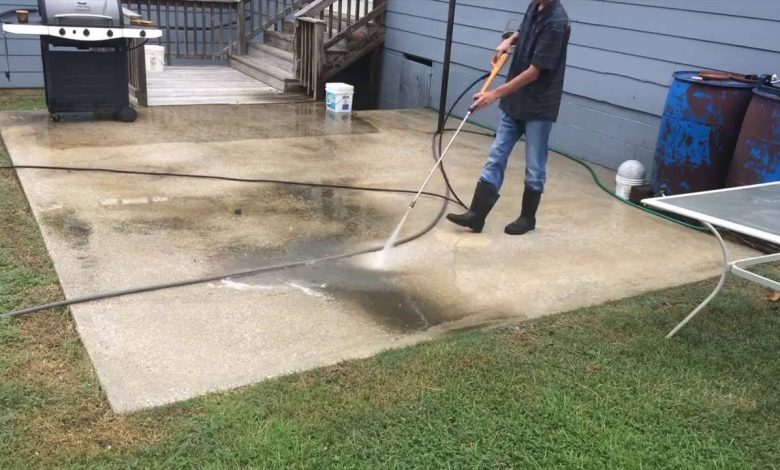
As the weather warms up outside, it’s a great time for homeowners to start enjoying their enclosed patios. Many of these patios often have concrete surfaces because of their durability and affordability. Nonetheless, over time, these surfaces can eventually build up dirt and begin to look discolored. Fortunately, all it takes is a few cleaning supplies and following some simple methods to keep a concrete patio looking clean all year round. Here are some steps you can follow to get your concrete patio cleaned up.
- Remove your furniture and objects.
Before starting any cleaning, you should always have your patio completely cleared. Take all of your furniture and any objects off of the patio and store them away. Keeping your possessions out of the way will prevent them from getting damaged by the water or your cleaning solutions. Metal furniture, in particular, can rust if it experiences prolonged exposure to moisture. Your lightweight furniture can be placed inside your home, and anything very heavy can be placed in your yard or on the sidewalk.
- Sweep the dirt away.
Grab a broom and sweep away any loose debris that’s on your patio. You should sweep away as much loose debris as you can. Doing that will allow you to easily reach the more stubborn stains underneath. You can also get an idea of the extent you’ll need to employ certain cleaning methods. Some substances can be harder to scrub away than others. Substances such as dried mulch, sidewalk chalk, or compact dirt might have to be scrubbed by hand with an abrasive sponge.
- Use a garden hose to spray the patio.
After sweeping the concrete, hose down the patio with a heavy stream of water. The dirt should be hosed off into the yard. If you haven’t cleaned your patio in a while, mix mild liquid dish detergent with warm water to create a soapy rinse. The soap will make it easier to effectively break down the dirt and oil. Be sure to wait until the concrete dries before you begin doing other cleaning methods that are more involved.
- Combine warm water with white vinegar.
Grab a bucket and pour an equal quantity of warm water and white vinegar. Once you pour both in, stir them together. The reason it’s good to use vinegar is that it’s naturally acidic. The acidity allows it to help lift and dissolve stains that are within the pores of the concrete better than water would alone. If you’re dealing with moss and mildew on your patio, add more vinegar into your bucket. In the event you might not have vinegar in your home, hydrogen peroxide mixed with water can also be just as effective. If you’re dealing with slightly heavier grime, you can add in a half cup of baking soda into your bucket.
- Pour the solution onto the concrete.
When you have everything mixed, you can pour the liquid on to the surface of the patio. Cover all of the concrete so the vinegar will be able to clean your surface evenly. You don’t have to be concerned about using too much, as vinegar can’t damage concrete. Make sure you’ve mixed up a large enough batch of the solution if you have a large patio area.
- Let the vinegar sit.
Despite being a useful natural cleaner, vinegar is very mild. As a result of its mildness, it’s likely going to take several hours to work. In that time, the vinegar solution will seep into the concrete, and break up all of the solidified dirt that’s trapped. You must plan your patio cleaning on a day that will be sunny. Avoid any rainy days, so that the rain won’t wash away the vinegar. While you’re waiting for the vinegar to work on your concrete, you can clean up some of your patio furniture.
- Scrub the patio.
When a few hours have passed, the worst of the dirt will probably be gone. With the remaining dirt or discoloration, use a push broom to scrub it away. You’ll want to avoid using any wire scrubbers, as this may scratch up your smooth surfaces. When you’ve finished using the broom, take your hose again, and hose off the patio.
- Use a high-powered pressure washer.
While most of the stains will usually be gone after you’ve done the previous steps, some stains can be tougher to get out. If you still see some stains such as rust, mold, or compacted dirt, you can use high-powered pressure water to try to get them out. What a pressure washer does is it releases a concentrated stream of water, which helps to chisel difficult blemishes from the concrete surface. If you don’t own a pressure washer, you can rent one at an affordable price from a gardening center or home improvement store.
When you’ve got your pressure washer assembled, point the nozzle of your pressure washer downward, and spray your patio surface. Move your nozzle in vertical sweeping motions to push any dislodged dirt off the patio. Since concrete doesn’t get damaged easily, feel free to use the highest setting. You also want to be sure that your surrounding patio is set up to be properly drained. If it’s not set up for proper drainage, you’ll have to deal with standing water.
- Let the concrete dry again.
After you’ve finished pressure washing, keep your patio clear until all of the water that’s left is drained and evaporated. If you want to speed up the process, use a towel to dry some of your concrete. Don’t put any of your patio furniture on the surface until it’s completely dry. If your furniture covers up portions of your concrete that’s damp, it won’t dry as quickly. With the area left moist and under the shade, it can allow mold to start growing. It’s ideal to pressure wash your concrete patios at least once or twice a year. If you allow dirt or any other substances to build up, it may eventually cause structural damage to your patio.
How to clean your concrete patio with bleach
If you don’t necessarily have all day to follow the previous steps, you can get your patio cleaned quicker with bleach. You’ll want to mix the bleach with some warm water. You should use about one-quarter of bleach per three quarts of water. Once you’ve poured them in the bucket, stir it together. Be mindful that bleach is a chemical that’s dangerous to ingest, inhale, or contact with bare skin. If you want to be on the safe side, wear a breathing mask and eye protection. You should also never combine bleach with hot water. The steam from the water can carry bleach fumes, creating a breathing hazard. Additionally, the heat can neutralize the effect of the bleach.
You can use a long-handled brush to apply the bleach solution, or you can put the solution in a sprayer to spray it on. Using a sprayer can make it less likely you’ll make a mess. You’ll want to apply the solution, particularly in any areas with heavy discoloration or spotted mildew growth. If your patio is enclosed, you’ll want to make sure it’s well-ventilated by leaving the windows and doors open. Avoid spending any longer than 10 minutes at a time inside your enclosed patio.
Unlike the vinegar solution that has to sit for hours, once you’ve applied the bleach solution, you’ll only have to let sit for 15 minutes. Bleach tends to work faster in getting rid of stains. Wait in another area while the solution is soaking into the concrete. In the event the bleach is cleaning the surface enough, you can try adding a sprinkle of trisodium phosphate to see if that might help. After the solution has soaked into the surface, spray the patio with a pressure washer to get rid of the dirt or residue. Using a pressure washer or hose to wash out the patio will also help clear out the bleach fumes. Once you’ve washed the surface, wait for your concrete surface to completely dry, and then place the furniture back on the patio.
Final concrete surface cleaning tips
Anytime you begin cleaning your concrete patio, always start with the gentlest method, and work your way up to stronger methods if necessary. You should regularly spray your patio with a hose or pressure washer set at a light to moderate setting to prevent any discoloration, which can cause buildup. Any mulch, paint, or charcoal stains need to be treated immediately to avoid them setting into your concrete permanently. Lastly, consider using a concrete sealant to finish off the cleaning of your patio. Concrete sealants are useful for protecting the surface from deterioration caused by moisture, dirt, and irregular pH levels due to hard water and soil deposits.
Regularly cleaning your concrete surface will allow you and your family and friends to enjoy your concrete patio for as long as possible. Another thing that can keep you enjoying your patio is outdoor roll down shades that can give you shade from the sun. You can learn more about them at this link: https://www.royalcovers.com/outdoor-roll-down-shades-patio-shades/.




